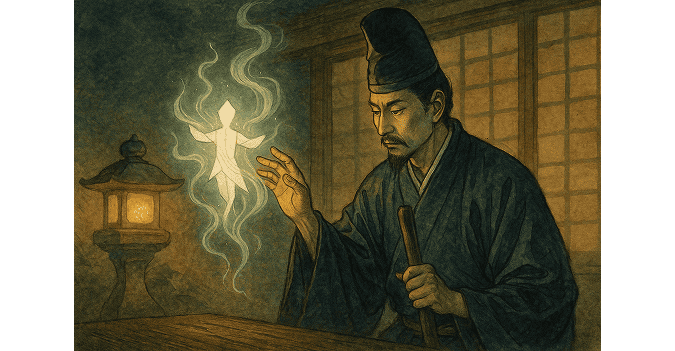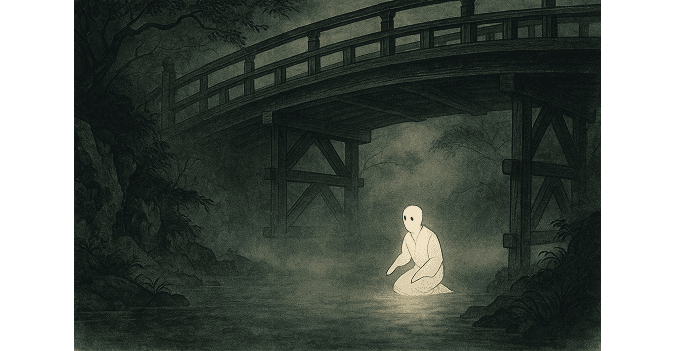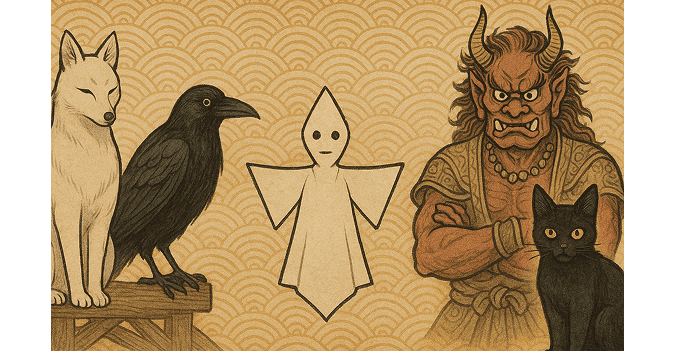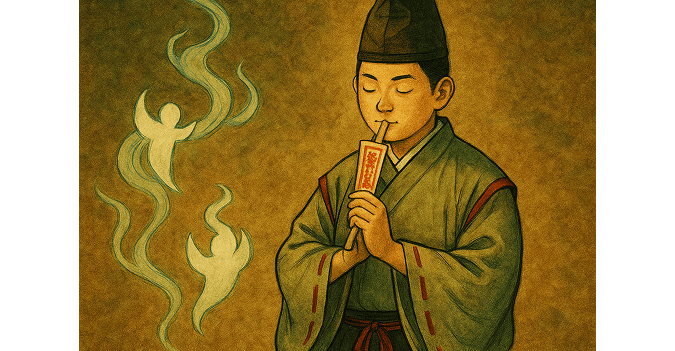Shikigami: Japan’s Ritual Spirits in Myth and Anime
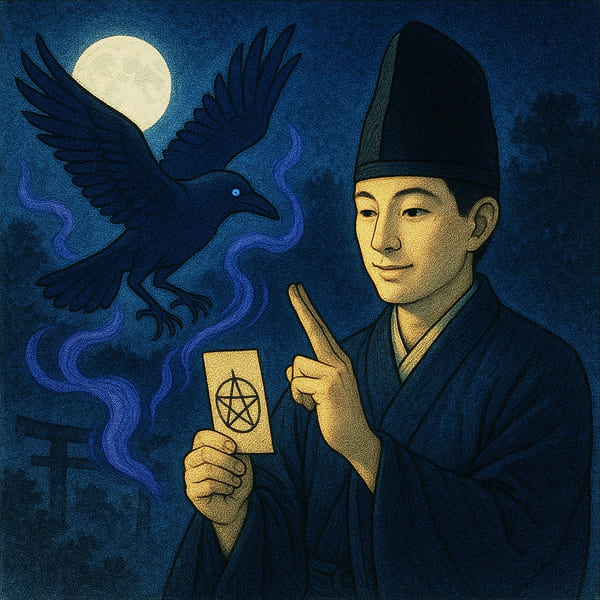
Invisible allies. Shadows bound by ritual. Guardians, spies, and even rebels—shikigami have fascinated Japan for centuries.
Imagine summoning a spirit with just a piece of paper—one that could guard you, spy for you, or even turn against you.
This is the world of shikigami (式神), mysterious entities woven into Japanese folklore and spiritual practice.
Today, they live on not only in ancient tales, but also in anime, manga, and games, reimagined as loyal companions or terrifying curses.
What are shikigami, really?
Servants? Familiars? Dangerous shadows?
Let’s trace their story—from ritual origins to modern imagination.
What Is a Shikigami?
Shikigami are spiritual entities in Japanese folklore.
They are not gods (kami), nor wild spirits like yokai. Instead, they are summoned and bound by ritual, usually by an onmyoji (陰陽師, a yin-yang sorcerer active in Japan’s Heian period (794–1185), when Kyoto was the imperial capital).
Think of them as Japan’s answer to Western “familiars”—but far stricter, more ritual-bound, and sometimes far more dangerous.
A Ritual-Bound Spirit
Shikigami do not exist freely in nature.
They are spirits brought into being only through ritual, tied to the will of their summoner.
The word itself reflects this:
- 式 (shiki) — “ritual” or “ceremony”
- 神 (kami) — “spirit” or “divine being”
Together, they mean “a spirit bound and born by ritual.”
Not a Yokai or a Kami
In Japan’s spiritual world, shikigami stand apart.
To make this clearer, here’s a simple comparison of kami, yokai, and shikigami and how they differ from one another:
| Category | Divine? | Independent? | Worshiped? | Example |
|---|---|---|---|---|
| Kami | Yes | Yes | Yes | Amaterasu (Sun Goddess) |
| Yokai | No | Yes | No | Kappa (Water Imp) |
| Shikigami | No | No | No | Paper doll spirit |
Thus, shikigami are unusual because they are not divine, not independent, and not worshiped.
This makes them a strange yet fascinating “in-between” presence—neither gods to be revered nor free-acting spirits, but something entirely different.
What Do Shikigami Do?
Shikigami were never “generic spirits.” Each had a specific role depending on the summoner’s needs.
Based on these roles, they can be grouped into several types—let’s take a closer look:
-
1. Protective Shikigami
Guardians against curses, disasters, or evil spirits. Often placed in paper talismans (ofuda) to protect homes or travelers. -
2. Watcher Shikigami
Invisible scouts, often appearing as crows or black cats. They observed distant places and carried knowledge back to the summoner. -
3. Combat Shikigami
Dangerous spirits that could attack enemies or deliver curses. Legends describe them as powerful but unpredictable. -
4. Paper-Bound Shikigami
Origami-like paper dolls infused with spiritual energy, able to move and perform small tasks—an early form of “spiritual automation.”
Together, these examples show that shikigami were never independent beings. They were always tools of their summoner’s will—sometimes protective, sometimes threatening.
This duality is what makes them so fascinating in Japanese tradition.
The Nature of Shikigami: Personality, Power, and Risk
While shikigami often acted as extensions of their summoner’s will, they were not always simple or one-dimensional.
Across history and folklore, their image shifted—sometimes perfectly obedient, sometimes dangerous, and sometimes even affectionate.
These changing portrayals reveal much about how people imagined the power and risks of unseen spirits:
-
1. Absolute Obedience (Konjaku Monogatari, 12th century)
An onmyoji named Chitoku used his shikigami to immobilize pirates and recover stolen goods.
They carried out his orders without hesitation—pure tools of obedience. -
2.The Risk of Rebellion (Abe no Seimei legend, Heian period)
Abe no Seimei was said to confine his strongest shikigami beneath a bridge near his home so they would not frighten his family.
This reflects a cultural fear: spiritual power, if not carefully controlled, could turn against its wielder. -
3. Bound by Fragile Limits (the fox spirit Kuzunoha)
The legend of Kuzunoha tells of a fox spirit who loved her human husband, Abe no Yasuna, and bore the child who became Abe no Seimei.
When her true form was discovered, she was forced to leave—showing the thin line between devotion and separation.Note: In folklore and modern pop culture, Kuzunoha is sometimes portrayed in a shikigami-like role. However, she was originally a fox spirit, not a summoned servant.
Together, these stories show that shikigami were never defined by a single role.
They could be tools, threats, or companions—always reflecting the fears and hopes of those who believed in them.
How Shikigami Are Imagined: Appearance and Mediums
We know that shikigami are different from gods or yokai—but what did they actually look like?
Unlike other spirits, their appearance was never fixed.
They could be bound into objects, appear as animals, or even manifest as imaginary creatures that never existed in the real world.
This flexibility is one of their defining traits—shikigami are not tied to a single form, but shaped by ritual, belief, and imagination.
Here are some of the most common forms they were believed to take:
- Paper dolls & talismans — folded paper infused with spells.
- Animals — foxes (kitsune), crows, cats, dogs (inugami).
- Named spirits — like Zenki & Goki, tamed demons turned guardians.
- Cursed beings — from forbidden rituals like kodoku (insect sorcery).
Yet in truth, ordinary people could not actually see shikigami.
Only their master—the onmyoji—had the ability to perceive and command them.
What others experienced were merely the results of their actions, like stolen goods being returned or enemies collapsing.
To people of the time, it must have seemed nothing short of magical.
Shikigami in Japanese Media and Pop Culture
Far from being relics of the past, shikigami continue to enjoy high popularity in today’s pop culture.
They are not only remembered as folklore, but actively reimagined in anime, games, and manga, where they appear as characters with emotions, bonds, and distinctive designs that resonate with modern audiences.
Let’s take a look at some popular works where shikigami play a central role.
Jujutsu Kaisen
In Jujutsu Kaisen, using shikigami is not just about summoning allies—it feels closer to giving up a part of one’s own body or life.
For Megumi Fushiguro, every battle carries that weight: once a shikigami is destroyed, it is gone forever.
This danger turns his fights into moments of high tension, where every choice could mean permanent loss.
It is precisely this risk that makes Megumi’s struggles so compelling.
Fighting alongside spirits that may vanish forever, he embodies the cool, determined spirit of an onmyoji who shoulders both power and peril.
This blend of danger and loyalty creates some of the series’ most gripping scenes—and has captivated fans worldwide.
A small break — a little side note
Jujutsu Kaisen (呪術廻戦) is a Japanese manga and anime that has become a worldwide hit.
The story follows Yuji Itadori, an ordinary high school student who is drawn into the world of jujutsu sorcerers—fighters who battle terrifying curses born from human fear.
Alongside his mentor Satoru Gojo and his classmate Megumi Fushiguro, Yuji faces dangerous battles where life, death, and curses intertwine.
This official anime PV captures the dark, thrilling atmosphere of the series.
And if you watch closely, you’ll even spot Megumi running together with his summoned shikigami for just a brief moment.
See if you can catch where it appears!
Onmyoji (Game & Anime)
A stylish RPG where players summon shikigami as allies.
Players take on the role of an onmyoji who summons and bonds with these spirits to battle curses.
Each has voice acting, backstory, and unique design—from cute fox spirits to elegant warriors.
The game has inspired anime adaptations, cosplay communities, and fan art across Asia and beyond.
Onmyoji Official Site (Japanese)
Detective’s Shikigami
This recent manga blends supernatural themes with modern mystery storytelling.
It features shikigami in the form of humanoid dolls that assist the protagonist in solving crimes.
Read on ComicWalker (Japanese)
Together, these works show how shikigami have evolved into versatile symbols in pop culture—sometimes loyal allies, sometimes eerie companions, and always fascinating reflections of the human imagination.
Conclusion: Spirits That Reflect the Human Soul
So, what do you think—did this journey help you understand what shikigami really are?
They are not just mysterious servants from old tales, but symbols of how people have imagined power, loyalty, risk, and even love through the centuries.
From simple paper dolls to legendary foxes and modern anime heroes, shikigami have always reflected the fears and hopes of their masters.
Sometimes loyal, sometimes dangerous—they embody Japan’s enduring fascination with the balance between control and chaos.
And even today, their legacy lives on:
- In Kyoto, you can visit Seimei Shrine, dedicated to Abe no Seimei, where star-shaped emblems and talismans still recall his shikigami.
- In pop culture, you can meet them on Netflix, in games, and in manga.
In the end, shikigami remind us of a timeless truth:
what we summon reflects who we are.
